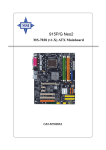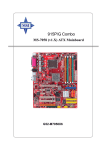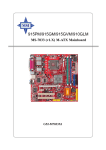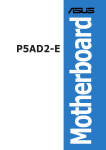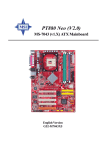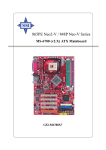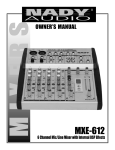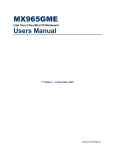Download MSI MS-7058 Instruction manual
Transcript
MS-7058 (v1.X) ATX Mainboard Winb ond W 83 6 27 TH F CPUFAN1 DIMM 2 DIMM 1 FDD 1 COM P ort US B p ort ATX1 JPW1 T: LAN j ack B: U SB p orts Intel 915P T:Line -I n M: L in e-Out B: Mi c T:R S-O ut M:C S -Ou t B:S PD I F Ou t IDE1 PCI_E1 SATA3 ICH6 PCI 1 JCD1 SATA1 PCI_E3 SATA4 BAT T + BIOS PCI_E2 SATA2 JBAT1 JLPC1 PCI 2 CM I 9880L PCI 3 JAUD1 JUSB1 J1394_2 i JUSB2 JFP2 JFP1 SYSFAN1 Manual Rev: 1.0 Release Date: May 2004 FCC-B Radio Frequency Interference Statement This equipment has been tested and found to comply with the limits for a class B digital device, pursuant to part 15 of the FCC rules. These limits are designed to provide reasonable protection against harmful interference when the equipment is operated in a commercial environment. This equipment generates, uses and can radiate radio frequency energy and, if not installed and used in accordance with the instruction manual, may cause harmful interference to radio communications. Operation of this equipment in a residential area is likely to cause harmful interference, in which case the user will be required to correct the interference at his own expense. Notice 1 The changes or modifications not expressly approved by the party responsible for compliance could void the user’s authority to operate the equipment. Notice 2 Shielded interface cables and A.C. power cord, if any, must be used in order to comply with the emission limits. VOIR LA NOTICE D’INSTALLATION AVANT DE RACCORDER AU RESEAU. Micro-Star International MS-7058 This device complies with Part 15 of the FCC Rules. Operation is subject to the following two conditions: (1) this device may not cause harmful interference, and (2) this device must accept any interference received, including interference that may cause undesired operation ii Copyright Notice The material in this document is the intellectual property of MICRO-STAR INTERNATIONAL. We take every care in the preparation of this document, but no guarantee is given as to the correctness of its contents. Our products are under continual improvement and we reserve the right to make changes without notice. Trademarks All trademarks are the properties of their respective owners. AMD, Athlon™, Athlon™ XP, Thoroughbred™, and Duron™ are registered trademarks of AMD Corporation. Intel® and Pentium® are registered trademarks of Intel Corporation. PS/2 and OS®/2 are registered trademarks of International Business Machines Corporation. Microsoft is a registered trademark of Microsoft Corporation. Windows® 98/2000/NT/ XP are registered trademarks of Microsoft Corporation. NVIDIA, the NVIDIA logo, DualNet, and nForce are registered trademarks or trademarks of NVIDIA Corporation in the United States and/or other countries. Netware® is a registered trademark of Novell, Inc. Award® is a registered trademark of Phoenix Technologies Ltd. AMI® is a registered trademark of American Megatrends Inc. Kensington and MicroSaver are registered trademarks of the Kensington Technology Group. PCMCIA and CardBus are registered trademarks of the Personal Computer Memory Card International Association. Revision History Revision V1.0 Revision History First release for PCB 1.X with Intel 915P & ICH6 iii Date July 2004 Safety Instructions 1. 2. 3. 4. 5. Always read the safety instructions carefully. Keep this User’s Manual for future reference. Keep this equipment away from humidity. Lay this equipment on a reliable flat surface before setting it up. The openings on the enclosure are for air convection hence protects the equipment from overheating. Do not cover the openings. 6. Make sure the voltage of the power source and adjust properly 110/220V before connecting the equipment to the power inlet. 7. Place the power cord such a way that people can not step on it. Do not place anything over the power cord. 8. Always Unplug the Power Cord before inserting any add-on card or module. 9. All cautions and warnings on the equipment should be noted. 10. Never pour any liquid into the opening that could damage or cause electrical shock. 11. If any of the following situations arises, get the equipment checked by a service personnel: h The power cord or plug is damaged. h Liquid has penetrated into the equipment. h The equipment has been exposed to moisture. h The equipment has not work well or you can not get it work according to User’s Manual. h The equipment has dropped and damaged. h The equipment has obvious sign of breakage. 12. Do not leave this equipment in an environment unconditioned, storage temperature above 60 0 C (140 0F), it may damage the equipment. CAUTION: Danger of explosion if battery is incorrectly replaced. Replace only with the same or equivalent type recommended by the manufacturer. iv CONTENTS FCC-B Radio Frequency Interference Statement ....................................................... iii Copyright Notice ........................................................................................................... iii Revision History ............................................................................................................ iii Safety Instructions ...................................................................................................... iv Technical Support ........................................................................................................ iv Chapter 1. Getting Started ................................................................................... 1-1 Mainboard Specifications ................................................................................... 1-3 Mainboard Layout ................................................................................................ 1-4 Chapter 2. Hardware Setup ................................................................................. 2-1 Quick Components Guide .................................................................................... 2-2 Central Processing Unit: CPU .............................................................................. 2-3 Introduction to LGA 775 CPU ..................................................................... 2-3 CPU & Cooler Installation ............................................................................ 2-4 Memory ................................................................................................................ 2-7 Introduction to DDR2 SDRAM ..................................................................... 2-7 Memory Module Population Rules .............................................................. 2-8 Installing DDR2 Modules ............................................................................. 2-8 Power Supply ....................................................................................................... 2-9 ATX 24-Pin Power Connector: ATX1 ......................................................... 2-9 ATX 12V Power Connector: JPW1 ............................................................ 2-9 Back Panel .......................................................................................................... 2-10 Mouse/Keyboard Connector .................................................................... 2-10 VGA Connector (Optional) ....................................................................... 2-10 Serial Port Connector ............................................................................... 2-11 USB Connectors ....................................................................................... 2-11 LAN (RJ-45) Jack ..................................................................................... 2-12 Audio Port Connectors ............................................................................. 2-12 Parallel Port Connector: LPT1 .................................................................. 2-13 Connectors ......................................................................................................... 2-14 Floppy Disk Drive Connector: FDD1 ........................................................ 2-14 Fan Power Connectors: CPUFAN2/SYSFAN1/NBFAN1/PWRFAN1 ....... 2-14 Hard Disk Connectors: IDE1, IDE2 & IDE3 (IDE 2 & IDE3 are optional) ............................................................. 2-15 Serial ATA/Serial ATA RAID Connectors controlled by Intel ICH6R: SATA1~SATA4 ........................................................... 2-16 v CD-In Connector: JCD1 ............................................................................ 2-17 Front Panel Connectors: JFP1, JFP2 ....................................................... 2-17 IEEE 1394 Connectors: J1394_1, J1394_2, J1394_3 (Optional) ........... 2-18 Front Panel Audio Connector: JAUD2 ..................................................... 2-18 IrDA Infrared Module Header: JIR1 .......................................................... 2-19 Front USB Connectors: JUSB1 & JUSB2 ................................................ 2-19 Chassis Intrusion Switch Connector: JCI1 ............................................. 2-20 D-Bracket™ 2 Connector: JDB1 .............................................................. 2-20 Jumpers ............................................................................................................. 2-21 Clear CMOS Jumper: JBAT1 .................................................................... 2-21 Slots ................................................................................................................... 2-22 PCI Express Slots ..................................................................................... 2-22 PCI (Peripheral Component Interconnect) Slots ...................................... 2-22 PCI Interrupt Request Routing .................................................................. 2-23 Chapter 3. BIOS Setup ........................................................................................... 3-1 Entering Setup ..................................................................................................... 3-3 Selecting the First Boot Device ................................................................. 3-2 Control Keys ............................................................................................... 3-3 Getting Help ................................................................................................ 3-3 Main Menu ................................................................................................... 3-3 Default Settings .......................................................................................... 3-3 The Main Menu ..................................................................................................... 3-4 Standard CMOS Features ................................................................................... 3-6 Advanced BIOS Features ................................................................................... 3-8 Advanced Chipset Features ............................................................................. 3-10 Integrated Peripherals ....................................................................................... 3-11 Power Management Features .......................................................................... 3-14 PNP/PCI Configurations ..................................................................................... 3-17 H/W Monitor ....................................................................................................... 3-19 Cell Menu ............................................................................................................ 3-21 BIOS Setting Password .................................................................................... 3-25 Load Fail-Safe/Optimized Defaults ................................................................... 3-26 Chapter 4. Introduction to CMI9880L Audio Codec ....................................... 4-1 Software Configuration ...................................................................................... 4-2 Main Setting ................................................................................................ 4-2 Smart Jack .................................................................................................. 4-6 Effect .......................................................................................................... 4-8 Information .................................................................................................. 4-8 vi vii Getting Started Chapter 1. Getting Started Getting Started Thank you for choosing the MS-7058 v1.X ATX mainboard. The MS-7058 v1.X ATX is based on Intel® 915P and Intel® ICH6 chipset for optimal system efficiency. Designed to fit the advanced Intel ® Pentium Prescott LGA775 processor, the MS-7058 v1.X ATX delivers a high performance and professional desktop platform solution. 1-1 7058 ATX Mainboard Mainboard Specifications CPU h Supports Intel® Pentium 4 Prescott LGA775 processors in LGA775 package. h Supports up to Pentium 4 3XX, 5XX & 7XX sequence processor or higher speed. h Supports Intel Hyper-Threading Technology. Chipset h Intel® 915P chipset - Supports FSB 533/800MHz. - Supports PCI Express x16 interface. h Intel® ICH6 chipset - Hi-Speed USB (USB2.0) controller, 480Mb/sec, up to 8 ports. - 4 Serial ATA ports with transfer rate up to 1.5Gb/s. - 1 channel Ultra ATA 100 bus Master IDE controller. - PCI Master v2.3, I/O APIC. - ACPI 2.0 Compliant. Main Memory h Supports two DDR1 SDRAM h Supports up to 2GB memory size. h Supports Dual channel DDR1 memory architecture. Slots h One PCI Express x16 slot (supports PCI Express Bus specification v1.0a compliant). h Two PCI Express x1 slots (supports PCI Express Bus specification v1.0a compliant). h Three 32-bit v2.3 Master PCI bus slots (support 3.3v/5v PCI bus interface). On-Board IDE h One Ultra DMA 66/100 IDE controllers integrated in ICH6. - Supports PIO, Bus Master operation modes. - Can connect up to Two Ultra ATA drives. h Serial ATA 150 controller integrated in ICH6. - Up to 150MB/sec transfer speed. - Can connect up to four Serial ATA devices. On-Board Peripherals h On-Board Peripherals include: - 1 floppy port supports 1 FDD with 360K, 720K, 1.2M, 1.44M and 2.88Mbytes - 1 serial port - 1 Line-In / Line-Out / MIC-In / Rear Speaker Out / Center-Subwoofer Speaker Out / SPDIF-Out optical and coaxial audio port - 8 USB ports (Rear * 4/ Front * 4) - 1 RJ-45 LAN jack 1-2 Getting Started LAN h Realtek® 8100C - Integrated Fast Ethernet MAC and PHY in one chip. - Supports 10Mb/s, 100Mb/s. - Compliance with PCI 2.2. - Supports ACPI Power Management. Audio h Azalia link controller integrated in Intel® ICH6 chipset. h 8-channel audio codec CMedia CMI9880L. - Compliance with Azalia 1.X Spec. - Supports Multi-Streaming function. - Supports Universal Audio Jack (only Front Audio Jack). BIOS h The mainboard BIOS provides “Plug & Play” BIOS which detects the peripheral devices and expansion cards of the board automatically. h The mainboard provides a Desktop Management Interface (DMI) function which records your mainboard specifications. Mounting and Dimension h ATX Form Factor: 24.4 cm (W) x 30.5 cm (L) h 9 mounting holes 1-3 7058 ATX Mainboard Mainboard Layout Win b on d W 836 27 TH F CPUFAN1 DIM M 2 DIM M 1 FDD 1 CO M P ort USB p ort ATX 1 JPW1 T: L AN jack B: USB po rt s Intel 915P/G T: L in e -In M: L in e-O ut B: Mic T:RS-O ut M:C S -Ou t B:SPD IF Ou t IDE1 PCI_E1 PCI 1 JCD1 S ATA3 ICH6/ ICH6R SATA1 PCI_E3 S ATA4 BAT T + BIOS PCI_E2 S ATA2 JBAT1 JLPC1 PCI 2 CM I 9880L PCI 3 JAUD1 J1394_2 JUSB1 JUSB2 MS-7058 v1.X ATX Mainboard 1-4 JFP2 JFP1 SYSFAN1 Hardware Setup Chapter 2. Hardware Setup Hardware Setup This chapter tells you how to install the CPU, memory modules, and expansion cards, as well as how to setup the jumpers on the mainboard. Also, it provides the instructions on connecting the peripheral devices, such as the mouse, keyboard, etc. While doing the installation, be careful in holding the components and follow the installation procedures. 2-1 MS-7058 ATX Mainboard Quick Components Guide JPW1, p.2-9 CPUFAN1, p.2-9 DDR DIMMs, p.2-7 FDD1, p.2-14 Back Panel I/O, p.2-10 ATX1, p.2-9 PCI Express x16, p.2-22 IDE1, p.2-15 JCD1, p.2-18 BATT + JBAT1, p.2-22 PCI Express x1, p.2-22 PWRFAN1, p.2-14 SYSFAN1, p.2-14 SATA1~SATA4, p.2-16 PCI Slots 1~3, p.2-22 JAUD1, p.2-18 JFP1, p.2-17 JFP2, p.2-17 J1394_1~J1934_3, p.2-18 2-2 JUSB1, JUSB2, p.2-19 Hardware Setup Central Processing Unit: CPU The mainboard supports Intel® Pentium 4 Prescott processor. The mainboard uses a CPU socket called LGA775. When you are installing the CPU, make sure to install the cooler to prevent overheating. If you do not have the CPU cooler, contact your dealer to purchase and install them before turning on the computer. MSI Reminds You... Overheating Overheating will seriously damage the CPU and system, always make sure the cooling fan can work properly to protect the CPU from overheating. Replacing the CPU While replacing the CPU, always turn off the ATX power supply or unplug the power supply’s power cord from grounded outlet first to ensure the safety of CPU. Introduction to LGA 775 CPU The pin-pad side of LGA 775 CPU. Alignment Key Yellow triangle is the Pin 1 indicator The surface of LGA 775 CPU. Remember to apply some silicone heat transfer compound on it for better heat dispersion. Alignment Key Yellow triangle is the Pin 1 indicator 2-3 MS-7058 ATX Mainboard CPU & Cooler Installation When you are installing the CPU, make sure the CPU has a cooler attached on the top to prevent overheating. If you do not have the cooler, contact your dealer to purchase and install them before turning on the computer. Meanwhile, do not forget to apply some silicon heat transfer compound on CPU before installing the heat sink/cooler fan for better heat dispersion. Follow the steps below to install the CPU & cooler correctly. Wrong installation will cause the damage of your CPU & mainboard. 1. The CPU has a land side cover on the bottom to protect the CPU contact from damage. Rotate it to make the pin 1 indicator (yellow triangle) in the rightbottom corner. 2. Take out the accompanying CPU Clip and rotate it for the same direction as the CPU (Pin 1 indicator, the red triangle is in the left-bottom corner). land side cover 3. Align the 3 points (the Pin 1 indicator and the two alignment keys) of both the CPU and the CPU Clip, and use your 4 fingers to push the CPU Clip down to clip them (the CPU clip is up and the CPU is down) together. 4. The land side cover now is removed. MSI Reminds You... 1. Confirm if your CPU cooler is firmly installed before turning on your system. 2. Do not touch the CPU socket pins to avoid damaging. 3. The availability of the CPU land side cover depends on your CPU packing. 2-4 Hardware Setup 5. The CPU has a plastic cap on it to protect the contact from damage. Before you have installed the CPU, always cover it to protect the socket pin. 6. Remove the cap from lever hinge side (as the arrow shows). 7. The pins of socket reveal. Then lift up the load lever. 8. Lift the load lever up and open the load plate. 9. Correctly align the red triangle of CPU clip with the CPU chamfer, the red arrow with the left-side socket edge, and the red spot to the hook of the socket. 10. Put the whole module onto the CPU socket. 2-5 MS-7058 ATX Mainboard 11. Push down the CPU hardly to install the CPU into the socket housing frame. 12. Visually inspect if the CPU is seated well into the socket, then remove the CPU Clip with 2 fingers. Then cover the load plate onto the package. 13. Press down the load lever lightly onto the load plate, and then secure the lever with the hook under retention tab. 14. Align the holes on the mainboard with the cooler. Push down the cooler until its four clips get wedged into the holes of the mainboard. 15. Press the four hooks down to fasten the cooler. Then rotate the locking switch (refer to the correct direction marked on it) to lock the hooks. 16. Turn over the mainboard to confirm that the clip-ends are correctly inserted. locking switch MSI Reminds You... 1. Check the information in PC Health Status of H/W Monitor in BIOS (refer to p.3-20 for details) for the CPU temperature. 2. Whenever CPU is not installed, always protect your CPU socket pin with the plastic cap covered (shown in Figure 1) to avoid damaging. 3. Please note that the mating/unmating durability of the CPU is 20 cycles. Therefore we suggest you do not plug/unplug the CPU too often. 2-6 Hardware Setup Memory The mainboard provides 2 slots for 184-pin DDR1 DIMM (Double In-Line Memory Module) modules which supports the memory size up to 2GB. Introduction to DDR SDRAM DDR1 SDRAM is similar to conventional SDRAM, but doubles the rate by transferring data twice per cycle. It uses 2.5 volts, and requires 184-pin DIMM modules. 2-7 MS-7058 ATX Mainboard Memory Module Population Rules Install at least one DIMM module on the slots. Each DIMM slot supports up to a maximum size of 1GB. Users can install either single- or double-sided modules to meet their own needs. While using dual-channel DDR function, it is available for you to install memory modules with different sizes, which will run in “asymmetric mode”. However, it is strongly recommended that you install same-size memory modules for better performance, which runs in “interleaved mode”. Please refer to the following table for the available memory populations. Other combination may cause damage to your mainboard. DIMM2 (DDR1) DIMM2 (DDR1) System Density 128MB~1GB 128MB~1GB * 128MB~1GB * 128MB~1GB 256MB~2GB ** 128MB~1GB 128MB~1GB *: single-channel **: dual-channel Installing DDR Modules 1. 2. 3. The DDR DIMM has only one notch on the center of module. The module will only fit in the right orientation. Insert the DIMM memory module vertically into the DIMM slot. Then push it in until the golden finger on the memory module is deeply inserted in the socket. The plastic clip at each side of the DIMM slot will automatically close. Volt Notch MSI Reminds You... You can barely see the golden finger if the module is properly inserted in the socket. 2-8 Hardware Setup Power Supply The mainboard supports ATX power supply for the power system. Before inserting the power supply connector, always make sure that all components are installed properly to ensure that no damage will be caused. ATX 24-Pin Power Connector: ATX1 This connector allows you to connect an ATX 24-pin power supply. To connect the ATX 24-pin power supply, make sure the plug of the pin 13 power supply is inserted in the proper orientation and the pins are aligned. Then push down the power supply firmly into the connector. You may use the 20-pin ATX power supply power supply as you like. If you’d like to use the 20-pin ATX power supply, please plug your power supply along with pin 1 & pin 13 (refer to the image at the right hand). There is also a foolproof design on pin 11, 12, 23 & 24 to avoid wrong installation. pin 12 Pin Definition 13 1 ATX1 24 12 PIN SIGNAL PIN SIGNAL 1 2 3 4 5 6 7 8 9 10 11 +3.3V +3.3V GND +5V GND +5V GND PWR OK 5VSB +12V +12V 12 NC 13 14 15 16 17 18 19 20 21 22 23 24 +3.3V -12V GND PS-ON# GND GND GND Res +5V +5V +5V GND ATX 12V Power Connector: JPW1 This 12V power connector is used to provide power to the CPU. JPW1 Pin Definition 4 2 JPW1 3 1 PIN SIGNAL 1 2 3 4 GND GND 12V 12V MSI Reminds You... 1. These two connectors connect to the ATX power supply and have to work together to ensure stable operation of the mainboard. 2. Power supply of 350 watts (and above) is highly recommended for system stability. 3. ATX 12V power connection should be greater than 18A. 2-9 MS-7058 ATX Mainboard Back Panel The back panel provides the following connectors: L-In RS-Out LAN USB Ports COM A L-Out CS-Out Mic SPDIF Out Serial Port Connector The mainboard offers one 9-pin male DIN connector as the serial port. The port is a 16550A high speed communication port that sends/receives 16 bytes FIFOs. You can attach a serial mouse or other serial devices directly to the connector. Pin Definition 1 2 3 4 5 6 7 8 9 9-Pin Male DIN Connector 2-10 PIN SIGNAL DESCRIPTION 1 2 3 4 5 6 7 8 9 DCD SIN SOUT DTR GND DSR RTS CTS RI Data Carry Detect Serial In or Receive Data Serial Out or Transmit Data Data Terminal Ready) Ground Data Set Ready Request To Send Clear To Send Ring Indicate Hardware Setup USB Connectors The mainboard provides an OHCI (Open Host Controller Interface) Universal Serial Bus root for attaching USB devices such as keyboard, mouse or other USBcompatible devices. You can plug the USB device directly into the connector. USB Port Description 1 2 3 4 5 6 7 8 USB Ports PIN SIGNAL DESCRIPTION 1 2 3 4 5 6 7 8 VCC -Data 0 +Data0 GND VCC -Data 1 +Data 1 GND +5V Negative Data Channel 0 Positive Data Channel 0 Ground +5V Negative Data Channel 1 Positive Data Channel 1 Ground LAN (RJ-45) Jack The mainboard provides 1 standard RJ-45 jack for connection to single Local Area Network (LAN). This enables data to be transferred at 100 or 10Mbps. You can connect a network cable to it. Giga-bit LAN Pin Definition RJ-45 LAN Jack PIN SIGNAL DESCRIPTION 1 D0P Differential Pair 0+ 2 D0N Differential Pair 0- 3 D1P Differential Pair 1+ 4 D2P Differential Pair 2+ 5 D2N Differential Pair 2- 6 D1N Differential Pair 1- 7 D3P Differential Pair 3+ 8 D3N Differential Pair 3- 2-11 MS-7058 ATX Mainboard Audio Port Connectors The left 3 audio jacks are for 2-channel mode for stereo speaker output: Line Out is a connector for Speakers or Headphones. Line In is used for external CD player, Tape player, or other audio devices. Mic is a connector for microphones. However, there is an advanced audio application provided by CMI9880L to offer support for 7.1-channel audio operation and can turn rear audio connectors from 2-channel to 4-/5.1-channel audio. Line In (Back Out in 7.1 CH) Line Out MIC 2-12 Rear Speaker Out (in 7.1CH / 5.1CH) Center/Subwoofer Speaker Out ( in 7.1CH / 5.1CH) S/PDIF Out-Optical (in 7.1CH / 5.1CH) Hardware Setup Connectors The mainboard provides connectors to connect to FDD, IDE HDD, case, LAN, USB Ports and CPU/System FAN. Floppy Disk Drive Connector: FDD1 The mainboard provides a standard floppy disk drive connector that supports 360K, 720K, 1.2M, 1.44M and 2.88M floppy disk types. FDD1 Fan Power Connectors: CPUFAN2/SYSFAN1/PWRFAN1 The CPUFAN2 (processor fan), SYSFAN1 (system fan 1), and PWRFAN1 (power fan) support system cooling fan with +12V. It supports four/three-pin head connector. When connecting the wire to the connectors, always take note that the red wire is the positive and should be connected to the +12V, the black wire is Ground and should be connected to GND. If the mainboard has a System Hardware Monitor chipset on-board, you must use a specially designed fan with speed sensor to take advantage of the CPU fan control. GND +12V Sensor Control CPUFAN2 GND +12V NC SYSFAN1 GND +12V NC PWRFAN1 MSI Reminds You... 1. Always consult the vendors for proper CPU cooling fan. 2. CPUFAN2 supports the fan control. 3. Please refer to the recommended CPU fans at Intel ® official website. 2-13 MS-7058 ATX Mainboard Hard Disk Connectors: IDE1 The mainboard has one 32-bit Ultra DMA 66/100 IDE controller integrated in ICH6, which supports PIO & Bus Master operation modes and it can connect up to two Ultra ATA drives. IDE1 IDE1 (Primary IDE Connector) The first hard drive should always be connected to IDE1. IDE1 can connect a Master and a Slave drive. You must configure second hard drive to Slave mode by setting the jumper accordingly. MSI Reminds You... If you install two hard disks on cable, you must configure the second drive to Slave mode by setting its jumper. Refer to the hard disk documentation supplied by hard disk vendors for jumper setting instructions. 2-14 Hardware Setup Serial ATA/Serial ATA RAID Connectors controlled by Intel ICH6: SATA1~SATA4 The SouthBridge of this mainboard is Intel ICH6 which supports four serial ATA connectors SATA1~SATA4. SATA1~SATA4 are dual high-speed Serial ATA interface ports. Each supports 1st generation serial ATA data rates of 150 MB/s. Both connectors are fully compliant with Serial ATA 1.0 specifications. Each Serial ATA connector can connect to 1 hard disk device. SATA4 SATA3 1 7 SATA1~ SATA4 Pin Definition PIN SIGNAL PIN SIGNAL 1 GND 2 TXP 3 5 7 TXN RXN GND 4 6 GND RXP 1 7 SATA2 SATA1 Serial ATA cable Take out the dust cover and connect to the hard disk devices Connect to serial ATA ports MSI Reminds You... Please do not fold the serial ATA cable in a 90-degree angle, since this might cause the loss of data during the transmission. 2-15 MS-7058 ATX Mainboard CD-In Connector: JCD1 The connector is for CD-ROM audio connector. R JCD1 GND L Front Panel Connectors: JFP1 & JFP2 The mainboard provides two front panel connectors for electrical connection to the front panel switches and LEDs. JFP1 is compliant with Intel® Front Panel I/O Connectivity Design Guide. Reset HDD Switch LED Power LED 1 2 9 10 1 2 7 8 JFP2 Power Switch Speaker JFP1 Power LED JFP1 Pin Definition PIN SIGNAL DESCRIPTION 1 2 3 4 5 6 7 8 9 HD_LED_P FP PWR/SLP HD_LED_N FP PWR/SLP RST_SW_N PWR_SW_P RST_SW_P PWR_SW_N RSVD_DNU Hard disk LED pull-up MSG LED pull-up Hard disk active LED MSG LED pull-up Reset Switch low reference pull-down to GND Power Switch high reference pull-up Reset Switch high reference pull-up Power Switch low reference pull-down to GND Reserved. Do not use. JFP2 Pin Definition 2-16 PIN SIGNAL PIN SIGNAL 1 GND 2 SPK- 3 5 7 SLED PLED NC 4 6 8 BUZ+ BUZSPK+ Hardware Setup IEEE 1394 Connectors: J1394_1, J1394_2, J1394_3 (Optional) The mainboard provides three 1394 pin headers that allow you to connect IEEE 1394 ports via an external IEEE1394 bracket. Pin Definition 1 2 9 10 J1394_1~J1394_3 PIN SIGNAL PIN SIGNAL 1 TPA+ 2 TPA- 3 Ground 4 Ground 5 TPB+ 6 TPB- 7 Cable power 8 Cable power 9 Key (no pin) 10 Ground Front Panel Audio Connector: JAUD1 The JAUD2 front panel audio connector allows you to connect to the front panel audio and is compliant with Intel® Front Panel I/O Connectivity Design Guide. 2 1 10 9 JAUD1 JAUD1 Pin Definition PIN SIGNAL DESCRIPTION 1 2 3 4 PORT 1L GND PORT 1R PRESENCE# 5 6 7 PORT 2R SENSE1_RETIRN SENSE_SEND 8 9 10 KEY PORT 2L SENSE2_RETIRN Analog Port 1 - Left channel Ground Analog Port 1 - Right channel Active low signal - signals BIOS that a High Definition Audio dongle is connected to the analog header. PRESENCE# = 0 when a High Definition Audio dongle is connected. Analog Port 2 - Right channel Jack detection return from front panel JACK1 Jack detection sense line from the High Definition Audio CODEC jack detection resistor network Connector Key Analog Port 2 - Left channel Jack detection return from front panel JACK2 2-17 MS-7058 ATX Mainboard Front USB Connectors: JUSB1 & JUSB2 The mainboard provides two standard USB 2.0 pin headers JUSB1 & JUSB2 . USB 2.0 technology increases data transfer rate up to a maximum throughput of 480Mbps, which is 40 times faster than USB 1.1, and is ideal for connecting highspeed USB interface peripherals such as USB HDD, digital cameras, MP3 players, printers, modems and the like. JUSB1 JUSB1 & JUSB2 Pin Definition (USB 2.0) 9 10 1 2 9 10 1 2 JUSB2 (USB 2.0) 2-18 PIN SIGNAL PIN SIGNAL 1 VCC 2 VCC 3 USB0- 4 USB1- 5 USB0+ 6 USB1+ 7 GND 8 GND 9 Key (no pin) 10 USBOC Hardware Setup Jumpers The motherboard provides the following jumpers for you to set the computer’s function. This section will explain how to change your motherboard’s function through the use of jumpers. Clear CMOS Jumper: JBAT1 There is a CMOS RAM on board that has a power supply from external battery to keep the system configuration data. With the CMOS RAM, the system can automatically boot OS every time it is turned on. If you want to clear the system configuration, use the JBAT1 (Clear CMOS Jumper ) to clear data. Follow the instructions below to clear the data: 1 JBAT1 3 3 1 1 Keep Data Clear Data MSI Reminds You... You can clear CMOS by shorting 2-3 pin while the system is off. Then return to 1-2 pin position. Avoid clearing the CMOS while the system is on; it will damage the mainboard. 2-19 MS-7058 ATX Mainboard Slots The mainboard provides one PCI Express x16 slot, two PCI Express x1 slots, and three 32-bit PCI bus slots. PCI Express Slots The PCI Express slots, as a high-bandwidth, low pin count, serial, interconnect technology, support Intel highest performance desktop platforms utilizing the Intel Pentium 4 processor with HT Technology. PCI Express architecture provides a high performance I/O infrastructure for Desktop Platforms with transfer rates starting at 2.5 Giga transfers per second over a PCI Express x1 lane for Gigabit Ethernet, TV Tuners, 1394 controllers, and general purpose I/O. Also, desktop platforms with PCI Express Architecture will be designed to deliver highest performance in video, graphics, multimedia and other sophisticated applications. Moreover, PCI Express architecture provides a high performance graphics infrastructure for Desktop Platforms doubling the capability of existing AGP8x designs with transfer rates of 4.0 GB/s over a PCI Express x16 lane for graphics controllers, while PCI Express x1 supports transfer rate of 250 MB/s. You can insert the expansion cards to meet your needs. When adding or removing expansion cards, make sure that you unplug the power supply first. PCI Express x16 slot PCI Express x1 slot PCI (Peripheral Component Interconnect) Slots The PCI slots allow you to insert the expansion cards to meet your needs. When adding or removing expansion cards, make sure that you unplug the power supply first. Meanwhile, read the documentation for the expansion card to make any necessary hardware or software settings for the expansion card, such as jumpers, switches or BIOS configuration. The orange PCI slot (PCI3) supports 2 masters, therefore it can also work as a communication slot. You may install the communication card on this slot, such as the wireless LAN PCI cards of MSI. PCI Slots 2-20 Hardware Setup PCI Interrupt Request Routing The IRQ, acronym of interrupt request line and pronounced I-R-Q, are hardware lines over which devices can send interrupt signals to the microprocessor. The PCI IRQ pins are typically connected to the PCI bus INT A# ~ INT D# pins as follows: Order 1 Order 2 Order 3 Order 4 PCI Slot 1 INT A# INT B# INT C# INT D# PCI Slot 2 INT B# INT C# INT D# INT A# PCI Slot 3 INT C# INT D# INT A# INT B# 2-21 BIOS Setup Chapter 3. BIOS Setup BIOS Setup This chapter provides information on the BIOS Setup program and allows you to configure the system for optimum use. You may need to run the Setup program when: An error message appears on the screen during the system boot up, and requests you to run SETUP. You want to change the default settings for customized features. MSI Reminds You... 1. The items under each BIOS category described in this chapter are under continuous update for better system performance. Therefore, the description may be slightly different from the latest BIOS and should be held for reference only. 2. While booting up, the BIOS version is shown in the 1st line appearing after the memory count. It is usually in the format: example: A7058IMS V1.0BH 04/23/04 where: 1st digit refers to BIOS maker as A=AMI(R); W=AWARD(R) 2nd - 5th digit refers to the model number. 6th - 7th digit refers to the customer, MS=all standard customers. V1.0BH refers to the BIOS version. 04/23/04 refers to the date this BIOS is released. 3-1 MS-7058 ATX Mainboard Entering Setup Power on the computer and the system will start POST (Power On Self Test) process. When the message below appears on the screen, press <DEL> key to enter Setup.Press <F11> key to enter the Boot menu. If the message disappears before you respond and you still wish to enter Setup, restart the system by turning it OFF and On or pressing the RESET button. You may also restart the system by simultaneously pressing <Ctrl>, <Alt>, and <Delete> keys. Selecting the First Boot Device You are allowed to select the 1st boot device without entering the BIOS setup utility by pressing <F11>. When the same message as listed above appears on the screen, press <F11> to trigger the boot menu. The POST messages might pass by too quickly for you to respond in time. If so, restart the system and press <F11> after around 2 or 3 seconds to activate the boot menu similar to the following. Select First Boot Device Floppy IDE-0 CDROM : 1st Floppy : IBM-DTLA-307038 : ATAPI CD-ROM DRIVE 40X M [Up/Dn] Select [RETURN] Boot [ESC] cancel The boot menu will list all the bootable devices. Select the one you want to boot from by using arrow keys and then pressing <Enter>. The system will boot from the selected device. The selection will not make changes to the settings in the BIOS setup utility, so next time when you power on the system, it will still use the original first boot device to boot up. 3-2 BIOS Setup Control Keys <↑> <↓> Move to the previous item Move to the next item <←> <→> Move to the item in the left hand Move to the item in the right hand <Enter> <Esc> Select the item Jumps to the Exit menu or returns to the main menu from a submenu <+> <-> Increase the numeric value or make changes Decrease the numeric value or make changes <F6> <F7> <F10> Load Optimized Defaults Load Fail-Safe Defaults Save all the CMOS changes and exit Getting Help After entering the Setup utility, the first screen you see is the Main Menu. Main Menu The main menu displays the setup categories the BIOS supplies. You can use the arrow keys ( ↑↓ ) to select the item. The on-line description for the selected setup category is displayed at the bottom of the screen. Default Settings The preset Optimal Defaults of the BIOS setup program provide optimal performance settings for all devices and the system. MSI Reminds You... The items under each BIOS category described in this chapter are under continuous update for better system performance. Therefore, the description may be slightly different from the latest BIOS and should be held for reference only. 3-3 MS-7058 ATX Mainboard The Main Menu Once you enter AMIBIOS NEW SETUP UTILITY, the Main Menu will appear on the screen. Use arrow keys to move among the items and press <Enter> to enter the sub-menu. Standard CMOS Features Use this menu for basic system configurations, such as time, date etc. Advanced BIOS Features Use this menu to setup the items of AMI® special enhanced features. Advanced Chipset Features Use this menu to change the values in the chipset registers and optimize your system’s performance. Integrated Peripherals Use this menu to specify your settings for integrated peripherals. Power Management Features Use this menu to specify your settings for power management. PNP/PCI Configurations This entry appears if your system supports PnP/PCI. H/W Monitor This entry shows the status of your CPU, fan, warning for overall system status. Frequency Control Use this menu to specify your settings for frequency/voltage control. 3-4 BIOS Setup Load Fail-Safe Defaults Use this menu to load the default values set by the BIOS vendor for stable system performance. Load Optimized Defaults Use this menu to load the default values set by the mainboard manufacturer specifically for optimal performance of the mainboard. BIOS Setting Password Use this menu to set the password for BIOS. Save & Exit Setup Save changes to CMOS and exit setup. Exit Without Saving Abandon all changes and exit setup. 3-5 MS-7058 ATX Mainboard Standard CMOS Features The items in Standard CMOS Features Menu includes some basic setup items. Use the arrow keys to highlight the item and then use the <+> or <-> keys to select the value you want in each item. Date (MM:DD:YY) This allows you to set the system to the date that you want (usually the current date). The format is <day> <month> <date> <year>. day Day of the week, from Sun to Sat, determined by BIOS. Read only. month The month from Jan. through Dec. date The date from 1 to 31 can be keyed by numeric function keys. year The year can be adjusted by users. Time (HH:MM:SS) This allows you to set the system time that you want (usually the current time). The time format is <hour> <minute> <second>. IDE Primary/Secondary/Third Master/Slave Press <+> or <-> to select the hard disk drive type. The specification of hard disk drive will show up on the right hand according to your selection. Press <Enter> for the sub-menu of each item: 3-6 BIOS Setup Device/Vendor/Size This item shows the information about the specified item. Read-only. LBA/Large Mode This item allows you to enable or disable the LBA (Logical Block Address, the logical block size in hard disk) mode. Setting options: [Auto], [Disabled]. DMA Mode This item allows you to enable or disable the DMA (Direct Memory Access) mode. Setting options: [Auto], [Disabled], [UDMA0], [UDMA1], [UDMA2], [UDMA3], [UDMA4], [UDMA5]. Auto Acoustic Management This optoin is used to set the level of acoustic management on this device. [Disable] does no management. [Medium] provides some management. [Silent] setting will make your device run quietly but the performance will be affacted. Hard Disk S.M.A.R.T. This allows you to activate the S.M.A.R.T. (Self-Monitoring Analysis & Reporting Technology) capability for the hard disks. S.M.A.R.T is a utility that monitors your disk status to predict hard disk failure. This gives you an opportunity to move data from a hard disk that is going to fail to a safe place before the hard disk becomes offline. Settings: [Auto], [Enabled], [Disabled]. Floppy A This item allows you to set the type of the floppy drives installed. Available options: [Disabled], [360 KB, 51/4], [1.2 MB, 51/4], [720 KB, 3 1/2], [1.44 MB, 3 1/2], [2.88MB, 3 1/2]. Halt On The setting determines whether the system will stop if an error is detected at boot. Available options are: [No Errors] The system doesn’t stop for any detected error. [All, But Keyboard] The system doesn’t stop for a keyboard error. System Information Press <Enter> to for the sub-menu of each item: Total Memory/BIOS Version This item shows the memory status and BIOS version of your system (read only). **CPU Information** Genuine Intel (R)/CPU ID/uCode ID/CPU Frequency The three items show the CPU related information of your system (read only). 3-7 MS-7058 ATX Mainboard Advanced BIOS Features Quick Boot Setting the item to [Enabled] allows the system to boot within 5 seconds since it will skip some check items. Available options: [Enabled], [Disabled]. Boot Sector Protection This function protects the BIOS from accidental corruption by unauthorized users or computer viruses. When enabled, the BIOS’ data cannot be changed when attempting to update the BIOS with a Flash utility. To successfully update the BIOS, you’ll need to disable this Boot Sector Protection function. You should enable this function at all times. The only time when you need to disable it is when you want to update the BIOS. After updating the BIOS, you should immediately re-enable it to protect it against viruses. Setting options: [Enabled], [Disabled]. Hyper-Threading Technology The processor uses Hyper-Threading technology to increase transaction rates and reduces end-user response times. The technology treats the two cores inside the processor as two logical processors that can execute instructions simultaneously. In this way, the system performance is highly improved. If you disable the function, the processor will use only one core to execute the instructions. Settings: [Enabled], [Disabled]. MSI Reminds You... Enabling the functionality of Hyper-Threading Technology for your computer system requires ALL of the following platform Components: * CPU: An Intel® Pentium® 4 Processor with HT Technology; * Chipset: An Intel® Chipset that supports HT Technology; * BIOS: A BIOS that supports HT Technology and has it enabled; * OS: An operating system that supports HT Technology. For more information on Hyper-threading Technology, go to: www.intel.com/info/hyperthreading 3-8 BIOS Setup IOAPIC Function This field is used to enable or disable the APIC (Advanced Programmable Interrupt Controller). Due to compliance with PC2001 design guide, the system is able to run in APIC mode. Enabling APIC mode will expand available IRQ resources for the system. Settings: [Enabled], [Disabled]. MPS Table Version This field allows you to select which MPS (Multi-Processor Specification) version to be used for the operating system. You need to select the MPS version supported by your operating system. To find out which version to use, consult the vendor of your operating system. Settings: [1.4], [1.1]. Full Screen LOGO Display This item enables you to show the company logo on the bootup screen. Settings are: [Enabled] Shows a still image (logo) on the full screen at boot. [Disabled] Shows the POST messages at boot. Boot Sequence Press <Enter> and the following sub-menu appears. 1st/2nd/3rd Boot Device These items allow you to set the sequence of boot devices where AMIBIOS attempts to load the operating system. MSI Reminds You... Available settings for “1st/2nd/3rd Boot Device” vary depending on the bootable devices you have installed. For example, if you did not install a floppy drive, the setting “Floppy” will not show up. Boot From Other Devices Setting the option to [Yes] allows the system to try to boot from other devices if the system fails to boot from the 1st/2nd/3rd boot device. Settings are: [Yes], [No]. 3-9 MS-7058 ATX Mainboard Advanced Chipset Features MSI Reminds You... Change these settings only if you are familiar with the chipset. Configure DRAM Timing by SPD Selects whether DRAM timing is controlled by the SPD (Serial Presence Detect) EEPROM on the DRAM module. Setting to [Auto By SPD] enables DRAM timings and the following related items to be determined by BIOS based on the configurations on the SPD. Selecting [Manual] lets users configure the DRAM timings and the following related items manually. Setting options: [Manual], [Auto By SPD], [Turbo], [Ultra]. Memory Hole In order to improve performance, certain space in memory can be reserved for ISA peripherals. This memory must be mapped into the memory space below 16MB. When this area is reserved, it cannot be cached. Settings: [Disabled], [15MB-16MB]. PEG Port This item enables or disables the PEG (PCI Express Graphic) port function. Setting options: [Enabled], [Disabled]. 3-10 BIOS Setup Integrated Peripherals USB Controller This setting is used to enable/disable the onboard USB host controller. Setting options: [Disabled], [Enabled]. USB Device Legacy Support Set to [Enabled] if you need to use any USB 1.1/2.0 device in the operating system that does not support or have any USB 1.1/2.0 driver installed, such as DOS. Set to [Disabled] only if you want to use any USB device other than the USB mouse. Setting options: [Disabled], [Enabled], [Auto]. Onboard LAN Controller The item enables or disables the onboard LAN controller. Setting options: [Enabled], [Disabled]. Onboard LAN Option ROM The item enables or disables the initialization of the onboard LAN Boot ROMs during bootup. Selecting [Disabled] will speed up the boot process. Setting options: [Enabled], [Disabled]. OnBoard IEEE1394 Controller (Optional) This setting is used to enable/disable the onboard IEEE 1394 controller. Setting options: [Enabled], [Disabled]. Onboard Audio Controller This item is used to enable or disable the onboard Azalia (Audio Codec) controller. Selecting [Enabled] allows the mainboard to enable the onboard Azalia controller. Disable the function if you want to use other controller cards to connect an audio device. Settings: [Disabled] and [Enabled]. 3-11 MS-7058 ATX Mainboard I/O Devices Configuration Press <Enter> to enter the sub-menu and the following screen appears: OnBoard Floppy Controller Select [Enabled] if your system has a floppy disk controller (FDC) installed on the system board and you wish to use it. Option Description [Enabled] Enables the onboard Floppy controller. [Disabled] Disables the onboard Floppy controller. COM Port 1 This item specifies the base I/O port addresses of the onboard Serial Port 1 (COM A). Selecting [Auto] allows AMIBIOS to automatically determine the correct base I/O port address. Settings: [3F8/IRQ4], [2F8/IRQ3], [3E8/IRQ4], [2E8/IRQ3] and [Disabled]. SATA Devices Configuration Press <Enter> to enter the sub-menu and the following screen appears: ATA/IDE Configuration, Configure SATA as These 2 items allow you to select the ATA/IDE and SATA configuration. Select [Disabled] in ATA/IDE Configuration if you want to disable both ATA/IDE configuration. Select [Compatible] or [Enhanced] to use the IDE, S-ATA and P-ATA devices. Refer to the following tables for details. ATA/IDE Configuration (Compatible) 3-12 SATA Only [SATA 1/3/2/4] PATA Pri, SATA Sec [IDE1, SATA2/4] SATA Pri, PATA Sec [SATA1/3, IDE1] PATA Only [IDE1] BIOS Setup ATA/IDE Configuration (Enhanced) IDE [IDE1, SATA 1/2/3/4] AHCI [IDE1, SATA 1/2/3/4] RAID [IDE1, SATA 1/2/3/4], [SATA support RAID 0 or 1] For the setting options of Configure SATA as, select [IDE] if you want to have SATA as IDE function. Select [AHCI] to allow the SATA to have Advanced Host Controller Interface (AHCI) feature, which supports improved serial ATA disk performance with native command queuing & native hot plug. Select [RAID] to use SATA as RAID function. Setting options: [IDE], [AHCI], [RAID]. 3-13 MS-7058 ATX Mainboard Power Management Features MSI Reminds You... S3-related functions described in this section are available only when your BIOS supports S3 sleep mode. ACPI Function This item is to activate the ACPI (Advanced Configuration and Power Management Interface) Function. If your operating system is ACPI-aware, such as Windows 98SE/ 2000/ME/XP, select [Enabled]. Settings: [Enabled] and [Disabled]. ACPI Standby State This item specifies the power saving modes for ACPI function. If your operating system supports ACPI, such as Windows 98SE, Windows ME, Windows 2000 and Windows XP, you can choose to enter the Standby mode in S1 (POS) or S3 (STR) fashion through the setting of this field. Options are: [S1/POS] The S1 sleep mode is a low power state. In this state, no system context is lost (CPU or chipset) and hardware maintains all system context. [S3/STR] The S3 sleep mode is a lower power state where the information of system configuration and open applications/files is saved to main memory that remains powered while most other hardware components turn off to save energy. The information stored in memory will be used to restore the system when a “wake up” event occurs. [Auto] BIOS determines the best setting automatically. Re-Call VGA BIOS at S3 Resuming When ACPI Standby State is set to [S3/STR], users can select the options in this field. Selecting [Yes] allows BIOS to call VGABIOS to initialize the VGA card when system wakes up (resumes) from S3 sleep state. The system resume time is shortened 3-14 BIOS Setup when you disable the function, but system will need an AGP driver to initialize the VGA card. Therefore, if the AGP driver of the card does not support the initialization feature, the display may work abnormally or not function after resuming from S3. Options: [Auto], [Yes], [No]. Suspend Time Out (Minute) If system activity is not detected for the length of time specified in this field, all devices except CPU will be shut off. Settings: [Disabled], [1], [2], [4], [8], [10], [20], [30], [40], [50], [60]. Power Button Function This feature allows users to configure the Power Button function. Settings are: [Power Off] The power button functions as a normal power-on/-off button. [Suspend] When you press the power button, the computer enters the suspend/sleep mode, but if the button is pressed for more than four seconds, the computer is turned off. Restore on AC/Power Loss This setting specifies whether your system will reboot after a power failure or interrupt occurs. Available settings are: [Off] Leaves the computer in the power off state. Wakeup[On] Event SetupLeaves the computer in the power on state. Press <Enter> and the Restores following sub-menu [Last State] the systemappears. to the previous status before power failure or interrupt occurred. Resume From S3 by USB Device The item allows the activity of the USB device to wake up the system from S3 (Suspend to RAM) sleep state. Setting options: [Disabled], [Enabled]. Resume by PCI/PCI-E Device This controls how and whether the system can be powered on by the devices installed on PCI/PCI-E slots. Setting options: [Disabled], [Enabled]. Resume On RTC Alarm This is used to enable or disable the feature of booting up the system on a scheduled time/date from the S3, S4, and S5 power off state. Setting options: [Disabled], [Enabled]. Date/Time (HH:MM:SS) If Resume By RTC Alarm is set to [Enabled], the system will automatically resume (boot up) on a specific date/hour/minute/second specified in these fields (using the <+> and <-> to select the date & time settings). Available settings for each item are: Date 01 ~ 31, Every Day Time (HH:MM:SS) 00 ~ 23 : 00 ~ 59 : 00 ~ 59 3-15 MS-7058 ATX Mainboard PNP/PCI Configurations This section describes configuring the PCI bus system and PnP (Plug & Play) feature. PCI, or Peripheral Component Interconnect, is a system which allows I/O devices to operate at speeds nearing the speed the CPU itself uses when communicating with its special components. This section covers some very technical items and it is strongly recommended that only experienced users should make any changes to the default settings. Clear ESCD The ESCD (Extended System Configuration Data) NVRAM (Non-volatile Random Access Memory) is where the BIOS stores resource information for both PNP and nonPNP devices in a bit string format. When the item is set to [Yes], the system will reset ESCD NVRAM right after the system is booted up and then set the setting of the item back to [No] automatically. Graphic Adapter Priority This setting specifies which VGA card is your primary graphics adapter. Setting options are: [PEG/PCI] The system initializes the PEG (PCI Express graphic) first. If a PCI Express graphic card is not available, it will initialize the PCI graphic card. [PCI/PEG] The system initializes the PCI graphic card first. If a PCI graphic card is not available, it will initialize the PEG (PCI Express graphic) card. PCI Latency Timer This item controls how long each PCI device can hold the bus before another takes over. When set to higher values, every PCI device can conduct transactions for a longer time and thus improve the effective PCI bandwidth. For better PCI performance, you should set the item to higher values. Setting options: [32], [64], [96], [128], [160], [192], [224], [248]. 3-16 BIOS Setup PCI Slot1 IRQ, PCI Slot2 IRQ, PCI Slot3 IRQ These items specify the IRQ line for each PCI slot. Setting options: [3], [4], [5], [7], [9], [10], [11], [12], [14], [15], [Auto]. Selecting [Auto] allows BIOS to automatically determine the IRQ line for each PCI slot. IRQ Resource Setup Press <Enter> and the following sub-menu appears. IRQ 3/4/5/7/9/10/11/14/15 These items specify the bus where the specified IRQ line is used. The settings determine if AMIBIOS should remove an IRQ from the pool of available IRQs passed to devices that are configurable by the system BIOS. The available IRQ pool is determined by reading the ESCD NVRAM. If more IRQs must be removed from the IRQ pool, the end user can use these settings to reserve the IRQ by assigning an [Reserved] setting to it. Onboard I/O is configured by AMIBIOS. All IRQs used by onboard I/O are configured as [Available]. If all IRQs are set to [Reserved], and IRQ 14/15 are allocated to the onboard PCI IDE, IRQ 9 will still be available for PCI and PnP devices. Available settings: [Reserved] and [Available]. DMA Resource Setup Press <Enter> and the following sub-menu appears. DMA Channel 0/1/3/5/6/7 These items specify the bus that the system DMA (Direct Memory Access) channel is used. The settings determine if AMIBIOS should remove a DMA from the available DMAs passed to devices that are configurable by the system BIOS. The available DMA pool is determined by reading the ESCD NVRAM. If more DMAs must be removed from the pool, the end user can reserve the DMA by assigning [Reserved] setting to it. 3-17 MS-7058 ATX Mainboard H/W Monitor This section shows the status of your CPU, fan, overall system status, etc. Monitor function is available only if there is hardware monitoring mechanism onboard. CPU Fan Failure Warning When enabled, the system will automatically monitor the CPU fan during boot-up. If it detects that the CPU fan is not rotating, the system will show an error message on the screen and halt the boot-up process. The function is built with CPU fan power connector (CPUFAN2) only and enables you to protect the CPU from possible overheating problem. If you don’t connect the CPU fan to the CPU fan power connector, we recommend disabling this feature. Setting options: [Enabled], [Disabled]. CPU Smart Fan Target Temp Select When the current temperature of the CPU fan reaches the value you specify here, the CPU fan will speed up for cooling down to avoid the CPU damage; on the contrary, if the CPU fan current temperature is lower than the specified value, the CPU fan will slow down its speed to keep the temperature stable. PC Health Status Press <Enter> and the following sub-menu appears. CPU/System Temperature, CPU/NB FAN Speed, Vcore, +3.3 V, +5.0 V, +12.0V, +5VSB These items display the current status of all of the monitored hardware devices/ components such as CPU voltages, temperatures and all fans’ speeds. 3-18 BIOS Setup Frequency Control The items in Cell Menu includes some important settings of CPU, AGP, DRAM and overclocking functions. MSI Reminds You... Change these settings only if you are familiar with the chipset. Current CPU Clock, Current DDR Memory Frequency These two items show the current clocks of CPU & DDR memory frequency. Readonly. Adjust CPU FSB Frequency This item allows you to select the CPU Front Side Bus clock frequency (in MHz) and overclock the processor by adjusting the FSB clock to a higher frequency. Setting options: For CPU FSB200: [200]~[500] For CPU FSB133: [133]~[500] CPU Ratio CMOS Setting This item allows you to adjust the CPU ratio. Setting to [Startup] enables the CPU running at the fastest speed which is detected by system. Adjust DDR Memory Frequency user can place an artificial memory clock limit on the system. Please note that memory is prevented from running faster than this frequency. Setting options: For DDR1: [Auto], [333], [400]. For DDR2: [Auto], [400], [533]. 3-19 MS-7058 ATX Mainboard Spread Spectrum When the motherboard’s clock generator pulses, the extreme values (spikes) of the pulses creates EMI (Electromagnetic Interference). The Spread Spectrum function reduces the EMI generated by modulating the pulses so that the spikes of the pulses are reduced to flatter curves. If you do not have any EMI problem, leave the setting at [Disabled] for optimal system stability and performance. But if you are plagued by EMI, activate the Spread Spectrum for EMI reduction. Remember to disable Spread Spectrum if you are overclocking because even a slight jitter can introduce a temporary boost in clock speed which may just cause your overclocked processor to lock up. Options: [Disabled], [Enabled]. 3-20 BIOS Setup BIOS Setting Password When you select this function, a message as below will appear on the screen: Type the password, up to six characters in length, and press <Enter>. The password typed now will replace any previously set password from CMOS memory. You will be prompted to confirm the password. Retype the password and press <Enter>. You may also press <Esc> to abort the selection and not enter a password. To clear a set password, just press <Enter> when you are prompted to enter the password. A message will show up confirming the password will be disabled. Once the password is disabled, the system will boot and you can enter Setup without entering any password. When a password has been set, you will be prompted to enter it every time you try to enter Setup. This prevents an unauthorized person from changing any part of your system configuration. 3-21 MS-7058 ATX Mainboard Load Fail-Safe/Optimized Defaults The two options on the main menu allow users to restore all of the BIOS settings to the default Fail-Safe or Optimized values. The Optimized Defaults are the default values set by the mainboard manufacturer specifically for optimal performance of the mainboard. The Fail-Safe Defaults are the default values set by the BIOS vendor for stable system performance. When you select Load Fail-Safe Defaults, a message as below appears: Pressing Y loads the BIOS default values for the most stable, minimal system performance. When you select Load Optimized Defaults, a message as below appears: Pressing Y loads the default factory settings for optimal system performance. 3-22 Introduction to CMI9880L Audio Codec Chapter 7. Introduction to CMI 9880L Audio Codec Introduction to CMI 9880L Audio Codec The motherboard comes with CMI9880L audio chip, which supports the brand new Azalia specification. In addition, C-Media designs a multi-stream function which allows the rear audio & front panel to play different audio sources simultaneously. CMI 9880L also allows the board to attach 4, 6, and 8 speakers for better surround sound effect. The section will guide you to experience the powerful features of this audio chip. 4-1 MS-7058 ATX Mainboard Software Configuration To have your 4-/6-/8-channel audio work, you must set appropriate configuration in the C-Media software application. Click the C-Media Mixer icon from the window tray on the bottom, and choose Open. Then the C-Media 3D Audio Configuration dialogue will appear. Click on the Main Setting tab to start the configuration of the audio. Main Setting 1. Output Device: Analog Output Here you can configure the preferred output device among earphone, 2channel speakers, 4-channel speakers, 6-channel speakers & 8-channel speakers. Click on the desired output device and the figure of the virtual speaker will change for the correct demonstration simultaneously. 4-2 Introduction to CMI9880L Audio Codec Click on the icon and the Speaker Environment dialogue appears. Bass Enhancement: You may enable the Bass Enhancement option to enhance the bass signal effect Center/Bass Output Swap: Enabling this option will exchange the center/bass output channel. PC speaker manufactures typically define that the center signal is delivered by tip of the stereo plug and the bass signal is by ring of it, as the figure showed below. However, some speakers have opposite definition. Please use this option to solve the possible trouble. Center Bass Bass Center In the left side, check the radio button next to the speaker to fit your audio devices. In the Audio Jacks tab in the right side, the audio will function as it shows. Please confirm you have connected your hardware to correct jacks before using. 2. Output Device: S/PDIF Output Click on the blue radio button to enable the S/PDIF output function. It will play Digital Audio to Digital S/PDIF Output. Choosing this option allows the output digital playing audio from your computer like DVD, VCD, digital CD, MP3, Wave... etc through S/PDIF in 48KHz sample rate. S/PDIF Out-Optical S/PDIF Out-Coaxial 3. Audio Jack This part shows the audio jack on your mainboard and indicates each function. 4-3 MS-7058 ATX Mainboard 4. DPS Mode: Disabled This part provides an advanced, amazing and considerate feature-dynamically adjustable multi-channel sound system no matter what listening appliance you are using and what application you are running. The default setting for DPS Mode is off, in which the hammer icon next to the DPS Mode and the 7.1 Virtual SPEAKER SHIFTER button remain gray. Here you can test each connected speaker to ensure if each channel audio operation works properly. If any speaker fails to make sound, then check whether the cable is inserted firmly to the connector or replace the bad speakers with good ones. Select the speaker by clicking it to test its functionality. The one you select will light up and make testing sound. 4-4 Introduction to CMI9880L Audio Codec 5. DPS Mode: Enabled This part provides an advanced, amazing and considerate feature-dynamically adjustable multi-channel sound system no matter what listening appliance you are using and what application you are running. Click the hammer icon next to the DPS Mode and click the 7.1 Virtual SPEAKER SHIFTER button, or click the 7.1 Virtual SPEAKER SHIFTER button directly to enable this function, then all the speakers are available to adjust. You may move all the virtual speakers to anywhere. Center is usually for Voice in DVD and just suitable to move in vertical to keep the sound in the center. Subwoofer signal is directionless low-frequency sound to human ears. Thus, please move it horizontally to express strength or weakness. Toolbar of DPS Mode <1> <1> <2> <3> <4> <5> <2> <3> <4> <5> Rotate all the virtual speakers clockwise. Rotate all the virtual speakers anti-clockwise. Move all the virtual speakers randomly. Move individual virtual speaker randomly. Reset the change to the default setting. 4-5 MS-7058 ATX Mainboard Smart Jack Here it indicates the audio output of each back panel jack. 1. Back Panel The audio configuration shown here should be identical to the audio jacks on your mainboard. Follow the indication on it to connect the audio output devices correctly. 2. Front Panel For the front panel audio jack, usually the green one is connected to Line-Out device while the pink one is for MIC. However, you can configure the definition as you wish by clicking the hammer icon, and select the preferred function in the Smart Jack Retasking Function dialogue. 4-6 Introduction to CMI9880L Audio Codec Effect From this part, you may choose the sound effect you like, such as environment effects, environment sizes and equalizers. You may also define your own equalizers and save them for the future usage. Information In this tab it provides some information about the Azalia Audio Configuration utility, including 3D Audio Engine, Audio Codec, Audio Driver Version, Audio Controller & DirectX Version. You may also select the language of this utility by choosing from the Language list. 4-7





























































